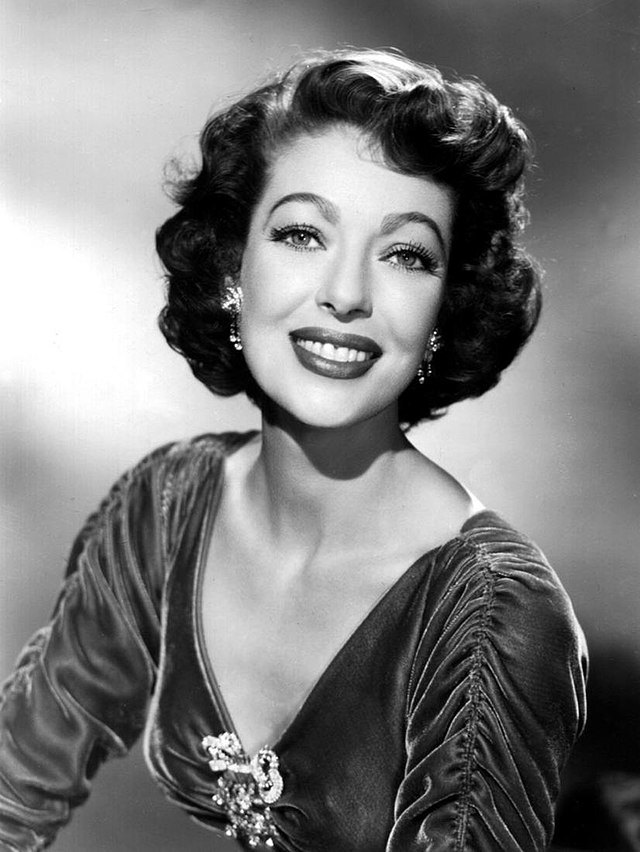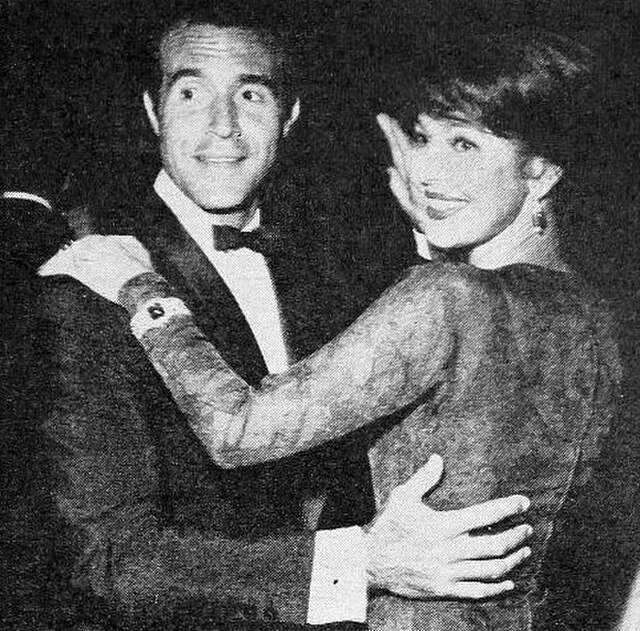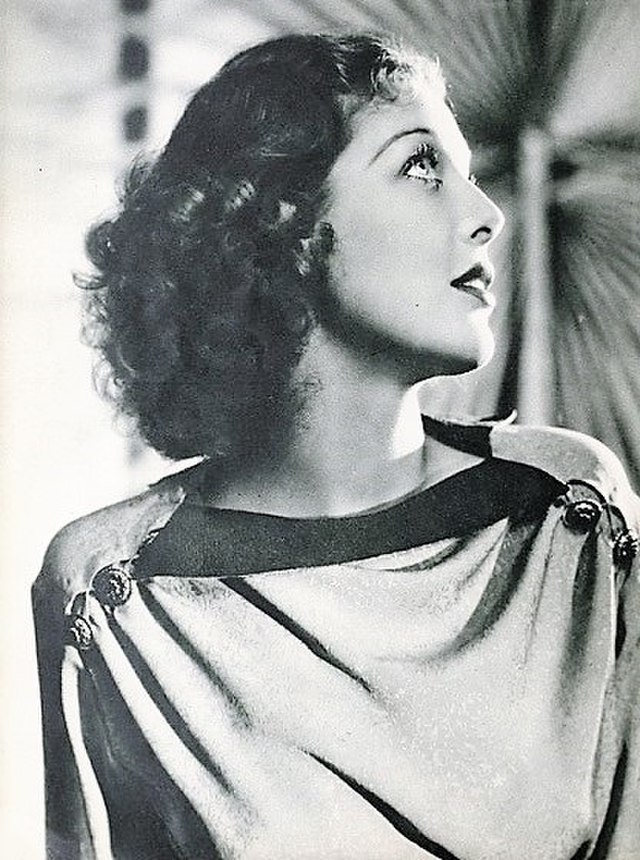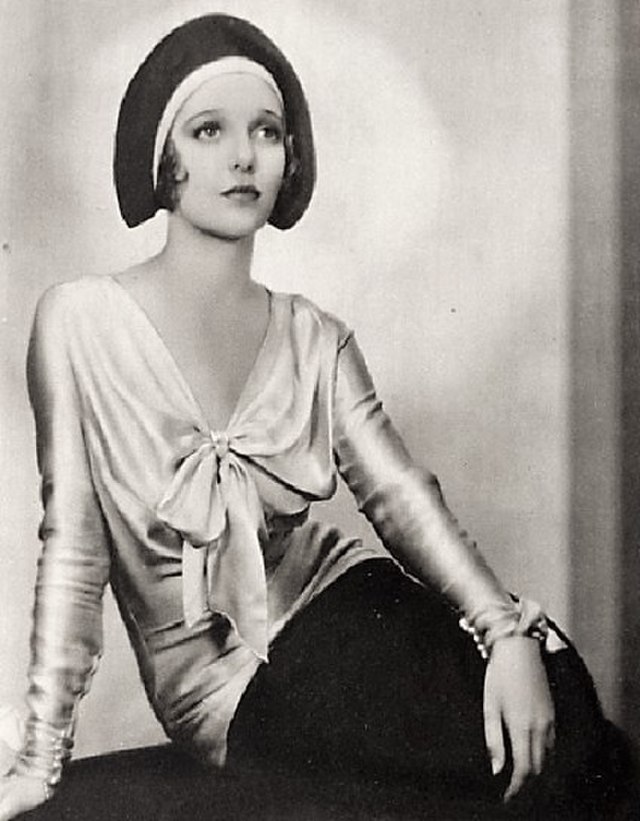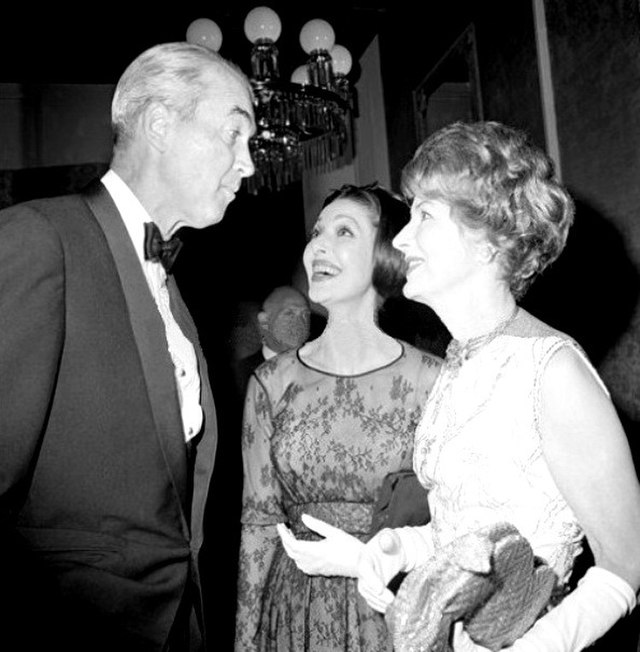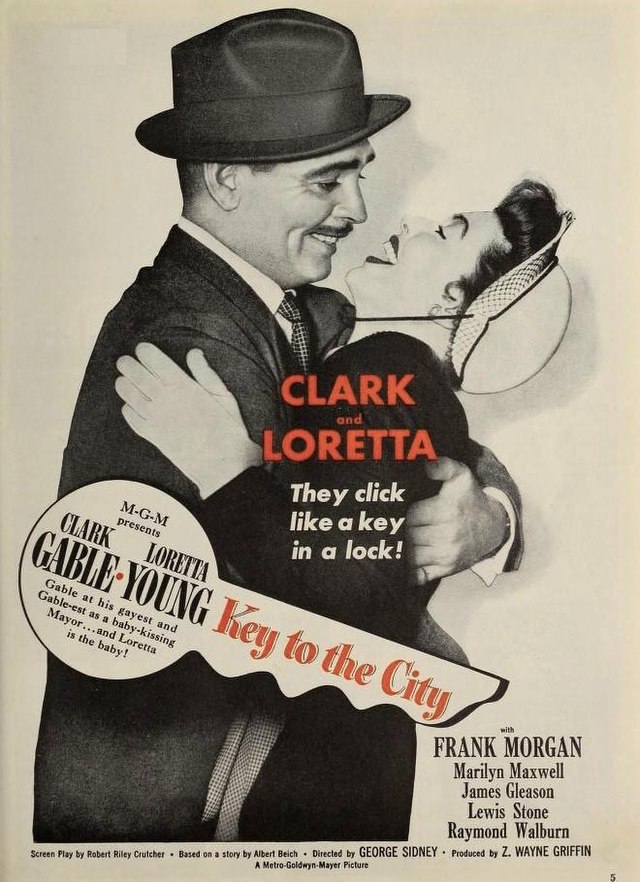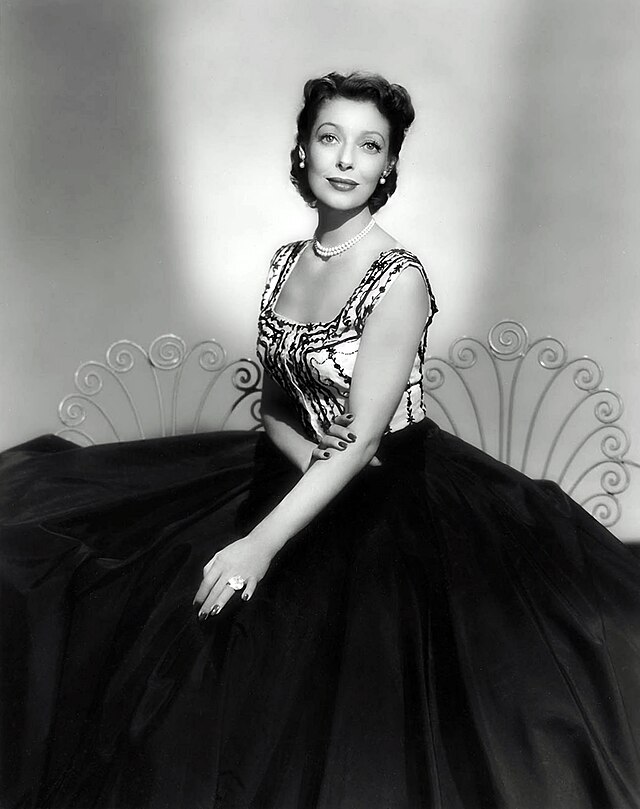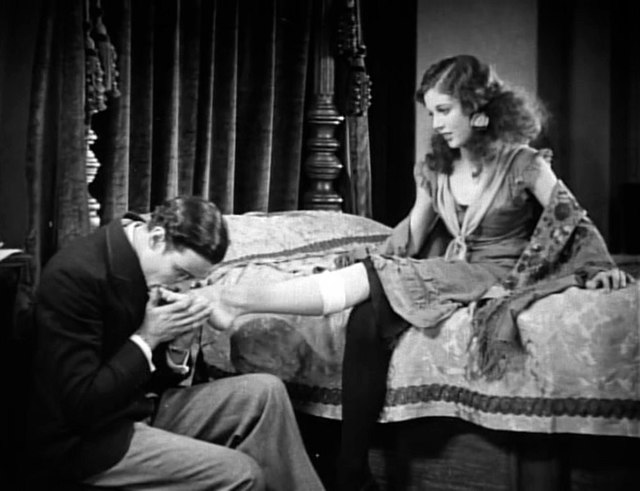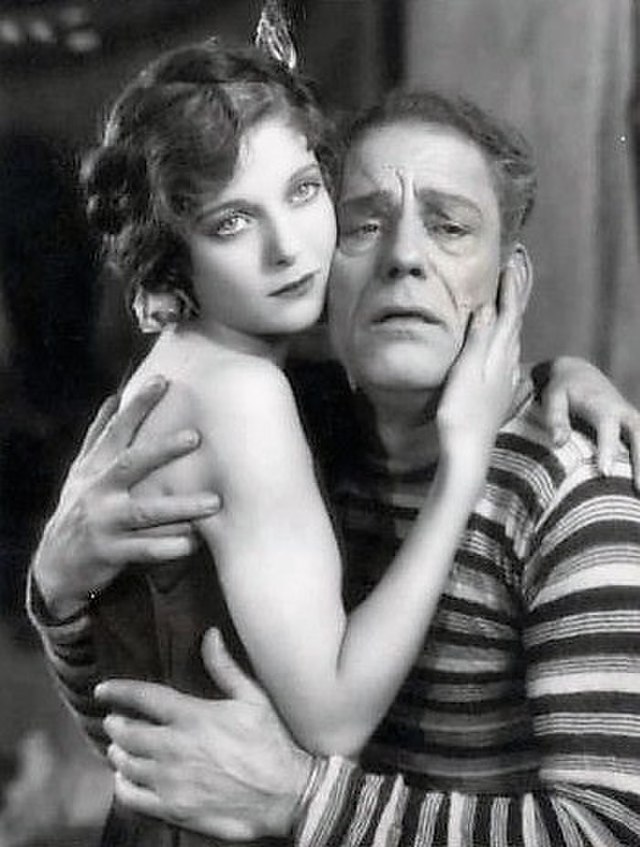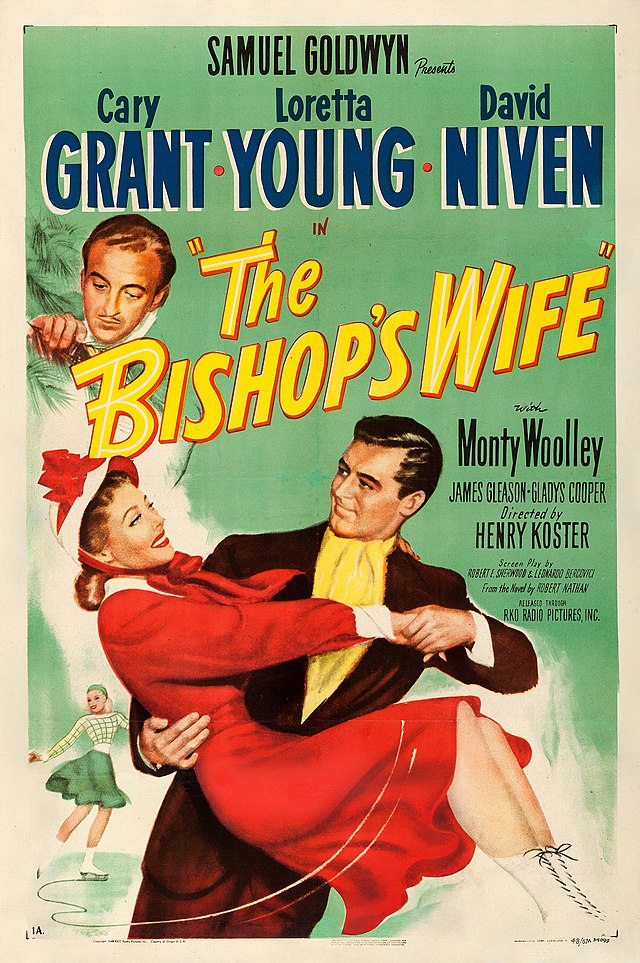Loretta Young
back| Full Name | Gretchen Michaela Young |
| Stage Name | Loretta Young |
| Born | January 6, 1913 |
| Birthplace | Salt Lake City, Utah, U.S. |
| Died | August 12, 2000 |
| Buried | Holy Cross Cemetery, Culver City, California |
| Married to | Grant Withers (m. 1930; annulled in 1931) - Thomas Lewis (m. 1940; div. 1969) - Jean Louis (m. 1993; died 1997) |
| Children | Christopher Lewis (son) - Peter Lewis (son) - Judy Lewis (daughter, her biological child with Clark Gable, born out of wedlock, though not publicly acknowledged by Young for many years) |
| Notable films | The Farmer's Daughter (1947) - The Bishop's Wife (1947) - Come to the Stable (1949) - The Stranger (1946) - A Night to Remember (1942) |
Loretta Young
The First Lady of Hollywood
Loretta Young (1913–2000) was a Hollywood icon whose career spanned over seven decades. She began acting as a child in silent films and became a leading lady in the 1930s and 1940s, known for her elegance, beauty, and versatility.
Young won an Academy Award for The Farmer’s Daughter (1947) and starred in classics like The Bishop’s Wife (1947) and The Stranger (1946). In the 1950s, she transitioned to television with The Loretta Young Show, winning three Emmy Awards.
Related
Loretta Young (1913 – 2000)
Biography and Movie Career
Loretta Young, born Gretchen Michaela Young on January 6, 1913, in Salt Lake City, Utah, was one of Hollywood’s most radiant and enduring stars. Over a career that spanned nearly seven decades, she evolved from a child actress in silent films to an Oscar-winning leading lady and a trailblazing television star. Her life, though marked by great achievements, was also filled with personal challenges, including a scandalous secret and three marriages. Through it all, she maintained a reputation for grace, professionalism, and religious devotion.
Early Life and Beginnings in Hollywood
Loretta Young was born into a Catholic family of four children. Her parents, Gladys Royal and John Earle Young, separated when she was just a toddler. Loretta’s mother moved her and her siblings to Hollywood, where she ran a boarding house for actors. Her older sisters, Polly Ann and Elizabeth Jane, also known as Sally Blane, were both actresses. Loretta’s entrance into show business seemed inevitable, and she began acting at the tender age of three in a silent film called The Primrose Ring (1917).
From early on, Young showed great promise in front of the camera, and her striking beauty made her stand out. By her teenage years, she had started working steadily in small film roles. Her big break came in 1928 when she starred opposite Lon Chaney in Laugh, Clown, Laugh. Soon after, her career skyrocketed, and she worked with prominent actors and directors, becoming one of the leading ladies of the 1930s.
Path to Success
Loretta Young had no trouble transitioning from silent films to talkies, an achievement that eluded many of her contemporaries. Her voice was considered one of her most powerful assets, along with her refined, elegant on-screen presence. In the 1930s, she starred in a series of successful films, including Platinum Blonde (1931) with Jean Harlow and The Crusades (1935), a Cecil B. DeMille production. These roles cemented her status as a Hollywood star.
Her star continued to rise throughout the 1930s and early 1940s, but it was in the post-war period that Young truly found herself in the upper echelon of Hollywood royalty. In 1947, she delivered one of the best performances of her career in The Farmer’s Daughter, portraying a Swedish maid who rises to political prominence. This role earned her the Academy Award for Best Actress, marking a high point in her career. That same year, she starred alongside Cary Grant and David Niven in The Bishop’s Wife, another beloved classic.
Personal Life and Marriages
Loretta Young’s personal life was filled with dramatic highs and lows. Her first marriage, at age 17, was to actor Grant Withers in 1930. The union was hasty and troubled from the start, leading to an annulment just a year later, in 1931. After that, Young remained focused on her career for most of the 1930s.
One of the most pivotal moments in her life occurred during the filming of The Call of the Wild (1935), where she had a highly publicized affair with Clark Gable, her co-star. The affair resulted in the birth of her daughter, Judy Lewis. However, in 1935, having a child out of wedlock was considered scandalous, particularly for someone with Young’s image. To preserve her reputation, Young went to great lengths to conceal her pregnancy, including taking a long break from Hollywood and arranging for her daughter to be raised as if she had been adopted. Young did not publicly acknowledge that Judy was her biological daughter until decades later, in her memoirs and interviews.
In 1940, Young married producer Thomas Lewis, with whom she had two sons, Christopher and Peter Lewis. The marriage lasted until 1969, but Young later described it as emotionally distant and unfulfilling. After her divorce, she would find happiness later in life with fashion designer Jean Louis, whom she married in 1993. He passed away in 1997, just a few years before her own death.
Devotion to Faith and Charity
Loretta Young’s Catholic faith was central to her identity and guided many of her decisions, both personal and professional. She was known to be deeply religious, attending mass regularly and even incorporating her beliefs into her acting career by rejecting roles she deemed inappropriate or morally questionable.
In addition to her work in film and television, Young was passionate about charitable causes. She supported many organizations and often used her celebrity to raise awareness for issues that mattered to her, including causes related to children, poverty, and the Catholic Church.
Television Career and The Loretta Young Show
After conquering the big screen, Young turned her attention to the emerging world of television in the 1950s. In 1953, she launched The Loretta Young Show, an anthology drama series in which she starred in many of the episodes. Young’s iconic entrance at the beginning of each episode, twirling in glamorous gowns, became a signature moment of early television. The show was a massive success, running until 1961 and earning Young three Primetime Emmy Awards. She became one of the first major movie stars to transition successfully to television, further solidifying her status as a beloved entertainer.
Later Years and Death
Loretta Young retired from acting in the 1960s, choosing to focus on her family and her faith. She lived a relatively quiet life after her final television appearances, though she remained a respected figure in Hollywood. Her daughter, Judy Lewis, published a memoir in 1994, revealing her long-kept secret as Clark Gable’s child, which caused some tension between mother and daughter. Despite the controversy, Young remained steadfast in her devotion to her family.
In her later years, Loretta Young suffered from various health issues, including hearing loss and complications from ovarian cancer. She passed away on August 12, 2000, at the age of 87 from ovarian cancer. Her death marked the end of an era, as she was one of the last surviving stars of Hollywood’s Golden Age. She was buried at Holy Cross Cemetery in Culver City, California, beside her family members.
Legacy
Loretta Young's legacy endures as one of the great actresses of classic Hollywood. She brought a unique blend of beauty, elegance, and versatility to her roles, capturing the hearts of audiences across generations. Her films, including The Farmer’s Daughter and The Bishop’s Wife, continue to be celebrated for their charm and her graceful performances. Beyond her professional achievements, she is remembered for her dedication to her faith and her strong moral convictions, which guided her through both triumphs and challenges in her remarkable life.
Video Bio on Loretta Young
The Affair between Clark Gable and Loretta Young
The relationship between Clark Gable and Loretta Young is one of the most talked-about Hollywood affairs, largely due to the secretive and complex nature of their connection. Their affair began during the filming of The Call of the Wild (1935), when Gable was already a major star, and Young, though younger, was an established actress. At the time of their relationship, Gable was married, which complicated matters significantly.
The Affair and its Secrecy
While working on the film in the wilds of Washington state, Gable and Young engaged in a brief, passionate affair. Young, a devout Catholic, was deeply concerned about her image and reputation, especially in an era when having a child out of wedlock was scandalous. When she discovered she was pregnant with Gable’s child, she went to great lengths to conceal the pregnancy from the public.
Loretta Young temporarily withdrew from public life, reportedly going on "vacation" and later to a Catholic maternity home, to avoid the press. She gave birth to their daughter, Judy, in 1935. To preserve her public image and avoid scandal, Young arranged for Judy to be raised in secret for a time and later adopted her, presenting the child as if she had been taken in from an orphanage.
The Public Deception
For decades, Loretta Young kept the truth about Judy Lewis’s parentage a secret, even from her daughter. Although there were rumors in Hollywood about Judy’s true paternity, especially because she bore a striking resemblance to Gable, neither Gable nor Young publicly acknowledged the affair or the child at the time. Gable never had a significant relationship with Judy, though he reportedly visited her once when she was a baby.
Later Years and the Revelation
It wasn’t until many years later that the truth was fully revealed. In 1966, Judy Lewis confronted her mother after piecing together the truth about her parentage, and Loretta confirmed that Clark Gable was her biological father. In 1994, Judy Lewis published her memoir, Uncommon Knowledge, detailing the emotional toll of discovering her true parentage and the complex relationship she had with her mother as a result.
Loretta Young, though fiercely protective of her image and reputation throughout her life, eventually acknowledged the affair in interviews late in her life. She admitted that her relationship with Gable, while brief, had profound consequences and left her with deep emotional scars due to the secrecy and societal pressures of the time.
The Lasting Impact
The affair between Clark Gable and Loretta Young left a lasting mark on both their legacies. While Gable remained one of the biggest stars in Hollywood, known as the "King of Hollywood," his relationship with Young and their child remained a shadowy aspect of his life. For Loretta Young, the affair was a defining personal struggle—balancing her public image as a devout Catholic and virtuous woman with the reality of her private life.
Their story remains one of Hollywood’s most poignant examples of the lengths stars would go to in order to protect their reputations during the Golden Age, and how the expectations of the time affected their personal lives.
Graceful Acting Style of Loretta Young
Loretta Young’s acting style was a unique blend of elegance, emotional depth, and a sense of quiet strength, which made her one of the most enduring stars of Hollywood’s Golden Age. Her career spanned silent films, talkies, and television, allowing her to adapt to changing mediums and showcase her versatility as an actress.
Grace and Elegance
One of the most distinctive aspects of Loretta Young's acting style was her natural grace and elegance. On screen, she carried herself with a poise that seemed effortless. This elegance was not just in her physical movements but in the way she delivered her lines—always with a refined and controlled presence that conveyed both intelligence and a sense of dignity. Whether playing a working-class farm girl, as in The Farmer’s Daughter, or a high-society woman, as in The Bishop’s Wife, Young embodied a timeless grace that became her signature.
Her style was polished, but she also brought an emotional sensitivity that made her performances deeply relatable. Even in roles where she played characters from privileged backgrounds, Young had an innate ability to make her portrayals feel genuine and grounded. This mixture of aristocratic poise and emotional sincerity allowed her to connect with audiences in a unique way, transcending the screen to make her characters feel both glamorous and accessible.
Emotional Range and Subtlety
Young was not a flamboyant or overly theatrical actress; rather, she excelled in subtlety. Her performances often relied on nuanced facial expressions, small gestures, and moments of quiet intensity to convey emotion. This subtlety was especially effective in her dramatic roles. In The Stranger (1946), where she plays the wife of a suspected Nazi war criminal, Young’s ability to convey a sense of growing dread and moral conflict without exaggerated dramatics helped build the tension in the film.
She was also skilled at portraying inner turmoil, showing a character’s struggle through restrained but powerful moments. In Cause for Alarm! (1951), she plays a woman whose husband believes she’s trying to kill him. The film showcases her talent for building suspense through quiet desperation, as she faces the psychological pressures of being falsely accused. Instead of overt emotional outbursts, Young’s performance subtly reveals her character’s panic and fear, making it all the more impactful.
Young often played characters who faced moral and emotional challenges, and her ability to portray these struggles with grace and dignity was one of her strongest assets. She never overplayed a scene but trusted in the audience's ability to pick up on the internal complexities of her characters.
Versatility and Adaptability
Loretta Young was known for her versatility. Over the course of her long career, she played a wide variety of roles, from romantic leads to dramatic heroines, from comedic parts to intense thrillers. She moved seamlessly between genres, and this adaptability was a key to her longevity in Hollywood.
In her early career, particularly in the 1930s, Young often played ingénues—youthful, innocent characters in films such as Platinum Blonde (1931) and The Truth About Youth (1930). Her beauty and charm suited these roles, but she quickly showed she was capable of more substantial performances. By the mid-1940s, she had matured into more complex characters, as seen in films like The Farmer’s Daughter (1947), where she plays a Swedish-American maid who works her way into political office. Here, she combined her natural charm with a sense of determination and moral integrity, winning her an Academy Award for Best Actress.
Her comedic timing was also sharp, and she showed a lightness of touch in romantic comedies like The Perfect Marriage (1947) and It Happens Every Thursday (1953). In these films, she brought warmth and humor, balancing the wit of the dialogue with her natural elegance.
At the same time, Young’s dramatic roles in films such as The Stranger (1946) and Rachel and the Stranger (1948) showcased her ability to bring emotional depth and gravitas to darker, more serious narratives. She could project vulnerability, courage, or moral conviction with equal skill, depending on the demands of the role.
On-Screen Presence and Connection with Co-Stars
Young had a magnetic screen presence. Even in films where she shared the stage with major male stars such as Cary Grant, Clark Gable, or Spencer Tracy, she held her own, often bringing a sense of balance and grounding to the dynamic. She had a remarkable ability to generate chemistry with her co-stars, which made her romantic pairings on screen believable and engaging.
In The Bishop’s Wife (1947), her understated yet radiant performance opposite Cary Grant was a key part of the film's charm. She brought a warmth to her role that complemented Grant's more ethereal character as an angel. Similarly, in The Call of the Wild (1935), her on-screen chemistry with Clark Gable was palpable, contributing to both the film’s success and their off-screen affair.
Moral Integrity and Influence of Her Faith
Loretta Young’s Catholic faith deeply influenced her career choices and acting style. She was known for her strong moral convictions, which led her to reject roles that she found too risqué or morally compromising. This sense of personal integrity was often reflected in the characters she chose to play—women who were strong, principled, and often had to navigate difficult moral landscapes.
In The Farmer’s Daughter and Come to the Stable (1949), where she played a nun seeking to build a hospital, Young's performances embodied a sense of moral clarity and decency. Her characters often seemed to represent her own beliefs, and she approached these roles with sincerity and a commitment to portraying virtuous women in challenging circumstances. This personal connection to her roles added an extra layer of authenticity to her performances, which resonated with audiences, especially during an era when traditional values were highly prized.
Memorable Quotes from Loretta Young
On Life and Values
- "I believe in living according to the Golden Rule, which is 'Do unto others as you would have them do unto you.' It’s the simplest formula for a successful life."
This quote reflects Loretta Young’s strong Catholic faith and her commitment to living by moral principles, which influenced both her personal life and her career choices. - "Love isn’t something you find. Love is something that finds you."
A classic, romantic sentiment from Young, who often portrayed characters who grappled with matters of the heart. This quote shows her belief in the unpredictability and serendipity of love. - "Fashion should be fun, and it's important to have a sense of humor about what you're wearing."
As a fashion icon, particularly known for her glamorous gowns, Loretta Young had a refined sense of style but believed in not taking it too seriously.
On Acting and Her Career
- "Wearing the correct dress for any occasion is a matter of good manners."
This often-quoted line reflects her emphasis on elegance and propriety, both on and off-screen. It also highlights her belief that style and presentation are extensions of one’s character. - "I’ve always tried to keep my personal life out of my work. I think the best way for an actress to play a role is to leave herself outside the door. That way, you can become the character, and the audience will believe in you."
Young’s approach to acting was professional and disciplined. This quote reflects her commitment to fully immersing herself in her roles without letting her private life interfere.
On Faith and Religion
- "I believe you have to live your faith. That’s the way I’ve tried to do it—whether in my work or in my private life."
As a devout Catholic, Loretta Young was known for making career choices that aligned with her moral values, rejecting roles she deemed inappropriate. This quote underscores her belief in living according to her faith, no matter the circumstances. - "I believe in the importance of family, faith, and helping others."
A simple, yet powerful summation of Young’s guiding principles, which she demonstrated throughout her life in her commitment to her children, her church, and her charity work.
On Success and Happiness
- "Success is a wonderful thing, but it does not make for happiness. Happiness is something you have to work at each day."
Despite her great professional success, Loretta Young believed that true happiness came from within and from the effort to live a good and fulfilling life each day. - "I don’t yearn for tomorrow. I want to live each day as it is, like it's a gift. That’s why it’s called the present."
This quote reflects her philosophy of mindfulness and living in the moment, a value she expressed later in her life.
On Aging and Beauty
- "A charming woman doesn’t follow the crowd; she is herself."
Loretta Young was admired for her grace and independence. This quote suggests that she believed in the importance of authenticity and individuality, particularly for women. - "The trick to aging gracefully is to enjoy it."
As someone who maintained her beauty and elegance well into her later years, Loretta Young embraced the idea of aging with poise and acceptance, showing that it’s a process to be celebrated, not feared.
What Others said about Loretta Young
Co-stars and Industry Peers
- Clark Gable (her co-star in The Call of the Wild and with whom she had a daughter, Judy Lewis):
While Gable never publicly commented in detail about their affair, he reportedly admired Young’s beauty and elegance, and their on-screen chemistry in The Call of the Wild was undeniable. Their personal relationship, though private, suggested mutual respect despite the complexities surrounding their secret child. - David Niven (her co-star in The Bishop’s Wife):
Niven praised Loretta Young’s beauty, but what stood out for him was her warmth and professionalism. He often commented on her ability to light up a room with her presence, calling her “radiant” and one of the “kindest people” in Hollywood. - Robert Mitchum (her co-star in Rachel and the Stranger):
Mitchum, known for his tough-guy persona, reportedly had a deep respect for Loretta Young’s strong work ethic and professionalism. He remarked that she had "an elegance and sense of humor that never failed to make the set a better place." - Cary Grant (her co-star in The Bishop’s Wife):
Cary Grant once said that Loretta Young “had an uncommon grace.” He admired how she balanced the glamour of Hollywood with a commitment to her personal values, noting that she had a rare ability to remain genuine despite the industry’s pressures. - Orson Welles (her director and co-star in The Stranger):
Orson Welles, known for being a perfectionist, praised Young’s professionalism and subtlety as an actress. He noted that her performance in The Stranger was key to building the tension and moral complexity of the film. Welles described her as "a star in the truest sense," someone whose presence elevated the work of those around her.
Critics and Film Historians
- Pauline Kael (film critic):
Kael noted that Loretta Young had "an ethereal quality that set her apart from other actresses of her time." She appreciated Young’s ability to balance roles in both light comedies and dramatic films, and how her performances were often marked by "a quiet emotional intensity." - Leonard Maltin (film critic and historian):
Maltin described Loretta Young as one of the few actresses who could transition so seamlessly from silent films to talkies. He often remarked on her versatility, noting that her success in both film and television was a testament to her talent. "Loretta Young was a true star of the Golden Age of Hollywood, and she helped define what it meant to be a leading lady." - David Thomson (film historian and critic):
In his book The New Biographical Dictionary of Film, Thomson said of Young: "She could make virtue seductive and yet maintain a sense of innocence." He admired how she brought an understated elegance to every role and called her "a woman who knew her craft but was never consumed by it."
Friends and Colleagues
- Jean Louis (her third husband and renowned costume designer):
Jean Louis, known for designing some of Loretta Young’s most iconic gowns, once said, "She was more than just beautiful. Loretta had a presence, an inner glow that no dress could enhance—only complement." He spoke about her elegance and taste, describing her as one of the most stylish women in Hollywood, but also as someone grounded by her strong values and commitment to her family. - Joan Fontaine (her fellow actress):
Fontaine once remarked, "Loretta Young was the epitome of glamour in her day, but she had a warmth about her that made everyone feel welcome. She was a generous friend and a consummate professional." - Ronald Reagan (former actor and U.S. President):
Reagan, who knew Loretta Young from their early days in Hollywood, called her "one of the most graceful and sincere people I ever met in the industry." He admired her commitment to her faith and her tireless work in support of charitable causes, noting that "she wasn’t just a star—she was a role model."
On Her Religious Devotion
- Mother Teresa (humanitarian):
Mother Teresa, whom Loretta Young greatly admired and supported, once said of her, "Loretta has given her heart to her work, to her family, and to her faith. Her generosity is a testament to her love for God."
Final Tributes
- Judy Lewis (her daughter with Clark Gable):
Judy Lewis, who initially struggled with the secrecy surrounding her parentage, later said in interviews, "My mother was a deeply loving person. She did what she thought was best for me, and I have nothing but respect for her strength and integrity." Lewis acknowledged that although their relationship was complicated, Young had been a devoted mother. - Shirley Jones (actress and goddaughter):
Shirley Jones spoke fondly of Loretta Young after her passing, saying, "She was like a second mother to me. Loretta was everything I aspired to be as an actress and as a woman. She showed me that you can be successful in Hollywood and still hold onto your morals and faith." - Gregory Peck (actor and friend):
After her death in 2000, Gregory Peck paid tribute to Young, saying, "Loretta was a beacon of grace and dignity in Hollywood. She was as kind and compassionate in her personal life as she was talented on screen. We have lost a true legend."
Awards and Recognition
Academy Awards (Oscars)
- Best Actress (Winner)
The Farmer’s Daughter (1947)
Loretta Young won the Academy Award for Best Actress for her portrayal of Katrin Holstrom, a Swedish-American maid who becomes a political figure. This role was one of her most iconic and solidified her status as one of the top actresses of her time. - Best Actress (Nominee)
Come to the Stable (1949)
Loretta Young was nominated for another Academy Award for her role as Sister Margaret, a nun who works to establish a children’s hospital. Her performance was praised for its warmth and sincerity.
Primetime Emmy Awards
- Best Actress (Winner)
The Loretta Young Show (1953-1961)
Loretta Young won three Primetime Emmy Awards for her work on The Loretta Young Show, a popular television anthology series that aired for eight seasons. The show featured Young in a variety of roles, and her entrance in glamorous gowns at the start of each episode became a hallmark. She won:- 1955: Emmy Award for Best Actress in a Regular Series
- 1957: Emmy Award for Best Continuing Performance by an Actress in a Leading Role in a Dramatic or Comedy Series
- 1959: Emmy Award for Best Lead Actress in a Drama
- Emmy Nominee
Young was nominated several more times for her work in television, continuing to demonstrate her influence in this medium well after her film career had reached its peak.
Golden Globe Awards
- Best Actress in a Television Series (Nominee)
The Loretta Young Show
Loretta Young received multiple Golden Globe nominations for her work on her television show, further highlighting her ability to transition successfully from film to TV. - Best Actress in a Miniseries or Television Film (Winner)
Christmas Eve (1986)
In her final screen appearance, Loretta Young won a Golden Globe for Best Actress for her role in Christmas Eve, a made-for-TV movie where she portrayed an elderly woman trying to reunite her family for the holidays. This win came more than four decades after her Academy Award, demonstrating her enduring talent and appeal.
Special Honors and Recognitions
- Hollywood Walk of Fame
Loretta Young was honored with two stars on the Hollywood Walk of Fame, one for her work in motion pictures and another for her contributions to television. These stars can be found at:- 6605 Hollywood Boulevard (for motion pictures)
- 6141 Hollywood Boulevard (for television)
- Photoplay Awards
Loretta Young won two Photoplay Awards for her work:- 1949: Photoplay Award for The Bishop’s Wife (Favorite Actress)
- 1950: Photoplay Award for Come to the Stable (Most Popular Female Star)
- Screen Actors Guild (SAG) Life Achievement Award (1988)
Young was awarded the SAG Life Achievement Award, one of the highest honors given by the acting community, for her outstanding career and contributions to the entertainment industry. - Women in Film Crystal Award (1988)
The Women in Film organization honored Loretta Young with a Crystal Award, recognizing her contributions to advancing the role of women in the entertainment industry. - Golden Apple Award
She was named the Most Cooperative Actress by the Hollywood Women's Press Club, reflecting her reputation as a professional and cooperative star on set.
Catholic Church Recognition
- Papal Honors
A devout Catholic, Loretta Young’s faith played a significant role in her life and career. She was honored by the Vatican and received several commendations from the Catholic Church for her dedication to her faith and for upholding Catholic values in her personal life and work.
Other Honors
- National Board of Review (NBR)
Loretta Young received recognition from the National Board of Review for her body of work and contributions to cinema. - Academy of Television Arts & Sciences Hall of Fame
Young was inducted into the Television Hall of Fame for her pioneering work in television, particularly for The Loretta Young Show, which was one of the earliest and most successful TV anthology series.
Legacy and Recognition in Later Years
Loretta Young’s contributions to the Golden Age of Hollywood and television were further recognized posthumously. Her influence as one of the first major movie stars to transition successfully to television helped pave the way for future generations of actors. Her career remains a model for those who seek to balance artistry with a strong personal ethos.
In her later years and even after her passing, Loretta Young was frequently cited as an inspiration to young actresses, and retrospectives of her work are often held in tribute to her lasting legacy.
Summary of Major Awards
- 1 Academy Award (Oscar) for Best Actress
- 3 Primetime Emmy Awards for Best Actress
- 1 Golden Globe Award for Best Actress
- 2 Stars on the Hollywood Walk of Fame
- SAG Life Achievement Award
- Women in Film Crystal Award
- Numerous nominations for Golden Globes and Emmys
- Papal honors and religious recognition for her dedication to Catholic values
Movies Starring Loretta Young
1920s
- The Primrose Ring (1917)
Young plays an uncredited role as a child in this silent film about a girl who brings joy to a children's hospital. - Sirens of the Sea (1917)
Loretta Young had another minor role as a child in this fantasy film about a group of sailors who discover a mystical undersea kingdom. - Naughty But Nice (1927)
A romantic comedy about a rich girl who disguises herself as poor to test the loyalty of her suitor. - Laugh, Clown, Laugh (1928)
Loretta Young stars alongside Lon Chaney in this tragic love story about a clown who falls in love with his adopted daughter. - The Whip Woman (1928)
A silent drama in which Loretta Young plays a minor role as a young girl involved in a complex romantic intrigue. - The Head Man (1928)
Young plays a secretary in this early talking picture, a political satire involving a corrupt mayor. - Scarlet Seas (1928)
This adventure film features a love triangle set aboard a ship. - The Careless Age (1929)
A drama about young lovers whose families try to keep them apart. - The Squall (1929)
A drama about a gypsy woman causing turmoil in a wealthy household.
1930s
- The Forward Pass (1930)
A football-themed drama about a star quarterback falling in love. - Kismet (1930)
A romantic adventure set in ancient Baghdad about a beggar who rises to power. - Loose Ankles (1930)
A romantic comedy about a young heiress who must marry to inherit her fortune. - The Truth About Youth (1930)
A romantic drama about a young man torn between his childhood sweetheart and an older, glamorous woman. - The Second Floor Mystery (1930)
A comedy-thriller involving a couple caught in a web of murder and mistaken identity. - War Nurse (1930)
A war drama centered on a group of nurses during World War I. - Three Girls Lost (1931)
A love triangle between three women and the men they fall for in the big city. - Beau Ideal (1931)
A sequel to "Beau Geste," focusing on a soldier's loyalty to his comrade. - The Right of Way (1931)
A drama about a man suffering from amnesia who finds redemption in a small town. - The Stolen Jools (1931)
A star-studded comedy short featuring several big names of the era, including Loretta Young, for a charity event. - Platinum Blonde (1931)
A romantic comedy about a newspaper reporter caught between a wealthy society girl and his working-class colleague. - Life Begins (1932)
A hospital drama about women from different backgrounds awaiting the birth of their babies. - Taxi! (1932)
Loretta Young stars opposite James Cagney in this drama about a taxi driver involved in gang violence. - Week Ends Only (1932)
A comedy about a wealthy woman who falls in love with a man she meets on vacation. - They Call It Sin (1932)
A love triangle between a small-town girl, a wealthy man, and her true love. - Grand Slam (1933)
A romantic comedy set in the world of competitive bridge playing. - The Devil's in Love (1933)
A drama about a soldier of fortune during the French Foreign Legion days. - Employees' Entrance (1933)
Young plays a department store employee caught up in an affair with her ruthless boss. - Man's Castle (1933)
Young stars opposite Spencer Tracy in this Depression-era romance about two drifters trying to make a life together. - She Had to Say Yes (1933)
A romantic drama about a woman hired to entertain male clients of a struggling clothing business. - The House of Rothschild (1934)
A historical drama about the rise of the Rothschild banking family. - Bulldog Drummond Strikes Back (1934)
A mystery film about a British adventurer solving a kidnapping. - The Crusades (1935)
An epic historical drama directed by Cecil B. DeMille about Richard the Lionheart and the Crusades. - Clive of India (1935)
A historical drama about Robert Clive's role in expanding the British Empire in India. - The Call of the Wild (1935)
Young stars opposite Clark Gable in this adaptation of Jack London's classic about a man and his dog in the Yukon Gold Rush. - The Unguarded Hour (1936)
A British courtroom drama about a man who inadvertently becomes involved in a blackmail scheme. - Ramona (1936)
A romantic drama about a young woman of mixed heritage struggling to find love and peace in Spanish California. - Wife, Doctor and Nurse (1937)
A romantic comedy about the complications in a love triangle between a doctor, his wife, and a nurse. - Love Under Fire (1937)
A romance set during the Spanish Civil War between a British officer and an American nightclub singer. - Four Men and a Prayer (1938)
A drama about four brothers who seek to clear their father's name after he's dishonorably discharged. - Three Blind Mice (1938)
A comedy about three sisters who try to marry into wealth but find love instead. - Kentucky (1938)
A drama about a family feud between two Kentucky horse-breeding families. - Suez (1938)
An epic historical drama about the construction of the Suez Canal, starring Tyrone Power. - Wife, Husband and Friend (1939)
A comedy about a man and wife who both secretly aspire to operatic careers. - The Story of Alexander Graham Bell (1939)
A biographical drama about the inventor of the telephone, featuring Young as Bell's wife, Mabel Hubbard Bell.
1940s
- The Doctor Takes a Wife (1940)
A romantic comedy about a writer and a doctor who pretend to be married, leading to complications. - He Stayed for Breakfast (1940)
A comedy about a woman who hides a political refugee in her apartment. - The Lady from Cheyenne (1941)
A western about a woman’s fight for women's suffrage in the American frontier. - Bedtime Story (1941)
A screwball comedy about a playwright and his actress wife whose relationship becomes increasingly turbulent. - A Night to Remember (1942)
A comedy-mystery about a couple who moves into a suspicious new apartment, only to become embroiled in a murder mystery. - China (1943)
A war drama set during World War II, in which Loretta Young plays a schoolteacher in China who helps a truck driver (played by Alan Ladd) escape the Japanese army. - Ladies Courageous (1944)
A patriotic film about the Women’s Airforce Service Pilots (WASP) during World War II, focusing on their brave contributions to the war effort. - And Now Tomorrow (1944)
A romantic drama about a wealthy, deaf woman (Loretta Young) who falls in love with the doctor attempting to cure her hearing loss. - Along Came Jones (1945)
A western comedy starring Gary Cooper, in which Young plays a feisty rancher who helps the bumbling Jones escape from bandits. - The Stranger (1946)
A classic film noir directed by Orson Welles, in which Loretta Young plays a woman who unknowingly marries a Nazi war criminal. - The Perfect Marriage (1947)
A romantic comedy about a seemingly perfect couple who decide to divorce after realizing they've grown apart, only to discover they still love each other. - The Farmer’s Daughter (1947)
Loretta Young’s Academy Award-winning performance as a Swedish-American farm girl who becomes a Congresswoman after working for a political family. - The Bishop’s Wife (1947)
A beloved holiday classic in which Young stars as the wife of a bishop who is visited by an angel (played by Cary Grant) trying to rekindle their marriage and faith. - Rachel and the Stranger (1948)
A romantic western about a widower who buys a bondservant woman (Young) to help raise his son, only to develop feelings for her. - Key to the City (1950)
A romantic comedy about the mayor of a small town who falls in love with a fellow mayor while attending a political convention. - Mother Is a Freshman (1950)
A lighthearted comedy about a mother who enrolls in college with her daughter and becomes the romantic interest of a professor. - Cause for Alarm! (1951)
A tense thriller in which Young plays a woman whose mentally ill husband, believing she's trying to kill him, tries to frame her for murder. - Half Angel (1951)
A fantasy comedy about a woman who sleepwalks and, during these episodes, believes she’s in love with a man from her past. - Paula (1952)
A drama about a woman who, after accidentally injuring a young boy in a car accident, takes him into her home to care for him, only to find herself falsely accused. - It Happens Every Thursday (1953)
A comedy about a couple who moves to a small town to take over a struggling local newspaper, only to find themselves caught in a series of humorous misunderstandings.
1950s
- Because of You (1952)
A drama about an ex-convict (Young) who struggles to rebuild her life after being released from prison, including finding love and redemption. - Platinum High School (1960)
A crime drama about a father investigating the mysterious death of his son at a military academy, where he uncovers corruption and violence.
After 1953, Loretta Young’s career shifted predominantly to television, where she found success with The Loretta Young Show, which ran from 1953 to 1961. She made only a few sporadic appearances in films after this, choosing to focus on her personal life and charitable endeavors.
Final Film and Television Roles
- The New Loretta Young Show (1962-1963)
A continuation of her original series, this show followed Young in a family-oriented sitcom, though it was not as successful as her earlier anthology series. - Christmas Eve (1986)
Young made her final screen appearance in this made-for-TV movie about an elderly woman who tries to reunite her family during the holiday season. She won a Golden Globe for her performance.

